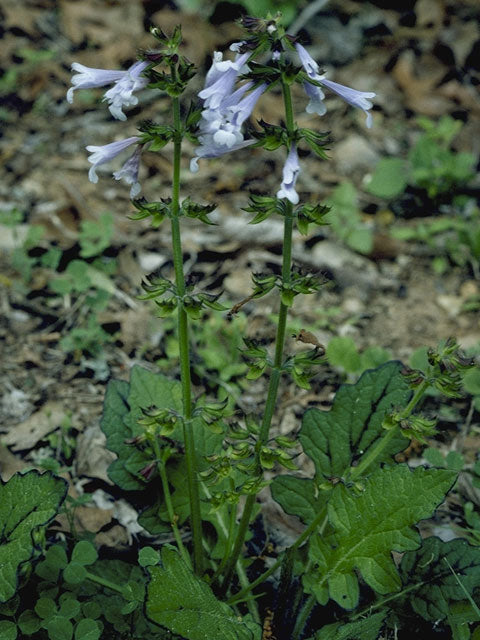Lyreleaf Sage (Salvia lyrata)
Lyreleaf Sage (Salvia lyrata)
Out of stock
Couldn't load pickup availability
Salvia lyrata L.
Lyreleaf Sage, Cancer Weed
Lamiaceae (Mint Family)
Synonym(s):
USDA Symbol: SALY2
Lyreleaf Sage is a strictly upright, hairy perennial, 1-2 ft. tall with a rosette of leaves at the base. The leaves are deeply 3-lobed, with a few simple leaves higher up on the stem. Large basal leaves are purple-tinged in the winter. This species has the typical square stem and 2-lipped blossom of the mints. Its pale-blue to violet, tubular flowers are arranged in whorls around the stem forming an interrupted, terminal spike. Each blossom is about 1 inch long. The 2-lobed lower lip is much longer than the upper, which has 3 lobes, the middle one forming a sort of hood. The sepals are purplish-brown.
Lyreleaf Sage makes a great evergreen ground-cover, with somewhat ajuga-like foliage and showy blue flowers in spring. It will reseed easily in loose, sandy soils and can form a solid cover with regular watering. It even takes mowing and can be walked on. The exposed lower lip of this and other salvias provides an excellent landing platform for bees. When a bee lands, the two stamens are tipped, and the insect is doused with pollen.
Plant Characteristics
Habit: Herb
Leaf Retention: Evergreen
Inflorescence: Raceme
Fruit Type: Nut
Size Notes: Up to about 2 feet tall, often shorter.
Leaf: Dark green. In winter, veined with dark purple.
Flower: Flowers 1 inch long
Fruit: Tan nutlets.
Bloom Time: Mar , Apr , May , Jun
Bloom Notes: Pale blue to lavender to white in color. In Texas, blooms for 4 or 5 weeks in spring.
Distribution
USA: AL , AR , CT , DC , DE , FL , GA , IL , IN , KS , KY , LA , MD , MO , MS , NC , NJ , NY , OH , OK , PA , SC , TN , TX , VA , WVNative Distribution: FL to e. TX, n. to NY, OH, MO, & KS. Eastern United States, Zones 6 to 9
Native Habitat: Rich, rocky, open woods; alluvial areas; wet to dry meadows. Well-drained sand or loam. In Texas, found in sandy soils of open woods, meadows, and clearings in the eastern fourth of the state.
Growing Conditions
Water Use: Low , MediumLight Requirement: Sun , Part Shade , Shade
Soil Moisture: Dry , Moist
Soil pH: Circumneutral (pH 6.8-7.2)
Drought Tolerance: Medium
Heat Tolerant: yes
Soil Description: Acid or calcareous sands, loams, or clays, well-drained or not.
Conditions Comments: Tolerates periodic flooding and can take drought and overwatering.
Benefit
Use Ornamental: An adaptable ground cover or perennial flower that can be mowed and has attractive foliage and blooms.Use Wildlife: Flowers attract hummingbirds and butterflies.
Conspicuous Flowers: yes
Interesting Foliage: yes
Fragrant Foliage: yes
Attracts: Butterflies , Hummingbirds
Nectar Source: yes
Deer Resistant: Moderate
https://www.wildflower.org/plants/result.php?id_plant=SALY2
Image Information
Photographer: Bransford, W.D. and DolphiaState: TX
Accession date: 1991-09-24
Filename: PCD3537_IMG0024.JPG
Slide Index: L1 91-546
Restrictions: Unrestricted
Collection: Wildflower Center Slide Library
Original Format: 35 MM
Orientation: Portrait
Shot: Whole Plant(s)
Date Taken: 1991
NPIN Image Id: 8884


